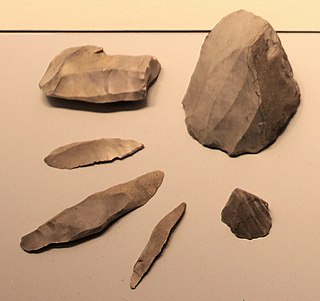
A microlith is a small stone tool usually made of flint or chert and typically a centimetre or so in length and half a centimetre wide. They were made by humans from around 35,000 years ago, across Europe, Africa, Asia and Australia. The microliths were used in spear points and arrowheads.

The Upper Paleolithic is the third and last subdivision of the Paleolithic or Old Stone Age. Very broadly, it dates to between 50,000 and 12,000 years ago, according to some theories coinciding with the appearance of behavioral modernity in early modern humans, until the advent of the Neolithic Revolution and agriculture.

The South Asian Stone Age spans the prehistoric age from the earliest use of stone tools in the Paleolithic period to the rise of agriculture, domestication, and pottery in the Neolithic period across present-day India, Pakistan, Bangladesh, Nepal, Bhutan, and Sri Lanka. As in other parts of the world, in South Asia, the divisions of the stone age into the Paleolithic, Mesolithic, and Neolithic periods do not carry precise chronological boundaries; instead, they describe broad phases of technological and cultural development based on the tools and artifacts found at various archaeological sites.
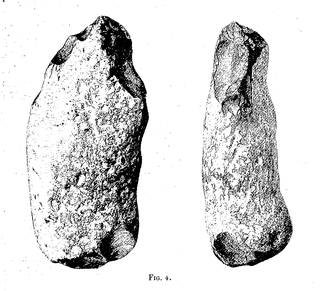
A geofact is a natural stone formation that is difficult to distinguish from a man-made artifact. Geofacts could be fluvially reworked and be misinterpreted as an artifact, especially when compared to paleolithic artifacts.

Azykh Cave, also referred to as Azokh Cave, is a six-cave complex in Azerbaijan, known as a habitation site of prehistoric humans. It is situated near the village of Azykh in the Khojavend District. The cave is an important prehistoric site which has been occupied by different human groups for a long time. The ancient layers of the Middle Paleolithic have yielded Neanderthal fossil remains that may date from around 300,000 years ago.
Archeological sites in Azerbaijan first gained public interest in the mid-19th century and were reported by European travellers.

Keezhadi, also spelt Keeladi, is a village near the village of Silaiman, on the border between Madurai and Sivagangai districts, in Tamil Nadu, India. The Keezhadi excavation site is located in this area: excavations carried out by the Archaeological Survey of India (ASI) and the Tamil Nadu Archaeology Department (TNAD) have revealed a Sangam era settlement dated to the 6th century BCE by radiocarbon dating. Claims that the results show that there was writing at that time have been challenged. It is not clear whether the potsherds containing inscriptions were found in the same archaeological layer as the 6th century samples, and University of Calcutta archaeologist Bishnupriya Basak said that "This unfortunately is not clear from the report and is very crucial", adding that the issues of "layer, period and absolute dates" needed clarity. Dravidian University archaeologist E. Harsha Vardhan said that a single report was not enough to "state scientifically that the Tamil-Brahmi script belongs to the sixth century BC".

Damjili – is a half-circular shaped cave site in Azerbaijan, where evidence of prehistoric human presence during the Paleolithic and Mesolithic was discovered.

The Taghlar cave is an archaeological site that was inhabited by prehistoric humans of the Mousterian culture during the Paleolithic. The cave is located in Azerbaijan, in the disputed region of Nagorno-Karabakh, in the southern part of Boyuk Taghlar village, on the left banks of the Guruchay River.

The Mladečské Caves are a cave complex in the municipality of Mladeč in the Czech Republic. It is located in the Třesín National Nature Monument within the Litovelské Pomoraví Protected Landscape Area.
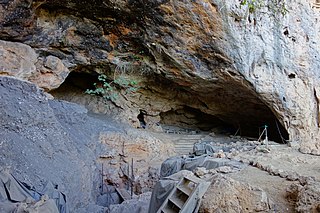
Taforalt, or Grotte des Pigeons, is a cave in the province of Berkane, Aït Iznasen region, Morocco, possibly the oldest cemetery in North Africa. It contained at least 34 Iberomaurusian adolescent and adult human skeletons, as well as younger ones, from the Upper Palaeolithic between 15,100 and 14,000 calendar years ago. There is archaeological evidence for Iberomaurusian occupation at the site between 23,200 and 12,600 calendar years ago, as well as evidence for Aterian occupation as old as 85,000 years.
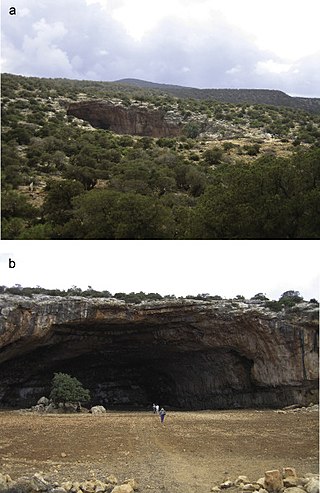
Haua Fteah is a large karstic cave located in the Cyrenaica in northeastern Libya. This site has been of significance to research on African archaeological history and anatomically modern human prehistory because it was occupied during the Middle and Upper Paleolithic, the Mesolithic and the Neolithic. Evidence of modern human presence in the cave date back to 200,000 BP.

The Obi-Rakhmat Grotto is a Middle Paleolithic prehistoric site that yielded Neanderthal fossils. It is a shallow karst cave near the junction of the Chatkal and Pskem Rivers at the southwestern end of the Talassky Alatau Range in the Tien Shan Mountains, 100 km (62 mi) northeast of Tashkent, Uzbekistan.

Trou de l’Abîme also known as La caverne de l'Abîme and Couvin Cave is a karst cave located in Wallonia on the right bank of the Eau Noire river in the center of Couvin, Belgium, in Namur province. During various archaeological excavations of sediment deposits, Mousterian artefacts and a Neanderthal molar were discovered.
Nwya Devu is a high-altitude archaeological site on the Tibetan Plateau located in the eastern Changtang region of Tibet. At around 4,600 m (15,092 ft) above sea level, Nwya Devu is the highest known archaeological site from the Paleolithic and provides evidence for one of the earliest known presences of humans at a high-altitude site, at around 40,000-30,000 BP.
Bambata Cave is one of the Southern Africa prehistoric sites situated in Motobo National Park along with Inanke, Nswatugi, Pomengwe and Silozwane caves in Zimbabwe.
Stone Age in Azerbaijan is divided into the Paleolithic, Mesolithic, and Neolithic periods. It was studied in Karabakh, Gazakh, Lerik, Gobustan, and Nakhchivan. Stone materials belonging to the Stone Age were found by Mammadali Huseynov in the Shorsu gorge located near the village of Gyrag Kasaman in Qazakh region. According to his research, people have first settled in the territory of Azerbaijan 2 million years ago. The Stone Age era involved two different human species: Homo neanderthalensis and Homo sapiens.
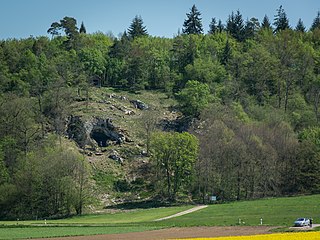
The Bockstein Cave, German: Bocksteinhöhle is part of the Bockstein complex – a White Jurassic limestone rock massif. The 15 by 20 m rock shelter, among small peripheral caves is situated around 12 m (39 ft) above the Lone River valley bottom, north of the towns of Rammingen and Öllingen, Heidenheim district in the central Swabian Jura, southern Germany. Several small openings, that are the actual entrances to the site, lead to various cave sections. The large frontal opening is of modern origin, created during the first excavation works in the late 19th century.

The history of West Bengal basically refers to the history of the western part of Bengal, located in the eastern part of the Indian subcontinent. Evidence of human settlement has been found in West Bengal about 42,000 years ago. The presence of human settlement of that period has been found in the Ayodhya Hills of West Bengal. By 2,000 BCE, settled life had increasingly spread of human civilization in the Damodar-Ajay River Valley, which was contemporary with the Harappa-Mahenjodaro civilization. The southern part of West Bengal witnessed the presence of the Vanga kingdom between 1100 BCE and 350 BCE, which was contemporary with the Vedic civilization of northern India.
Dhaba is a Middle Paleolithic archaeological site on the banks of the Son River in the Indian state Madhya Pradesh. According to carbon 14 dating, construction of the settlement began around 80,000 years ago. In 1983, the prehistoric settlement at Dhaba village was jointly discovered by Researchers from University of Allahabad, Karnatak University, Banaras Hindu University, University of Oxford and University of Queensland. During the excavations microlithic artefacts were discovered.
















